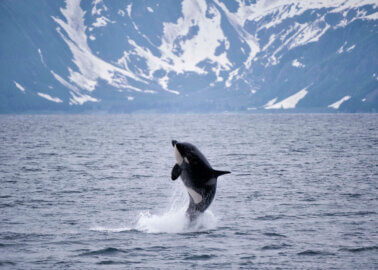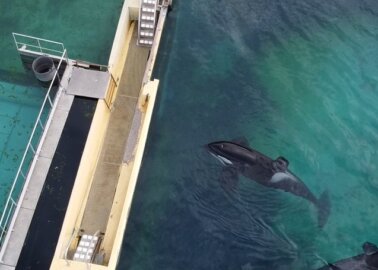A First-of-Its-Kind Robotic Dolphin? SeaWorld, Take Note
Torn away from their families and kept in small, prison-like pools, dolphins are harmed by programmes that allow humans to swim with them. But what if you could experience swimming with them without the harm? A first-of-its-kind robotic dolphin could make all our dreams – most importantly, those of dolphins – come true.
Roger Holzberg and Walt Conti of San Francisco–based Edge Innovations have created a jaw-dropping animatronic dolphin that has the potential to upend the cruel captive marine mammal industry. These visionary designers have thrown a lifeline to sensitive dolphins exploited in “swim with dolphins” encounters and archaic marine parks. PETA US is honouring Holzberg and Conti with an Innovator for Animals Award for making waves with the high-tech invention.

PETA Australia is also sending an Innovator for Animals Award to Melanie Langlotz of Geo AR Games in New Zealand for her pivotal work with Edge Innovations to create the animatronic dolphin.
“But I love dolphins!” will never be an OK excuse for paying to swim with live ones.
If you’ve watched The Cove, you already understand why we’re so grateful to innovators such as Holzberg, Conti, and Langlotz. Thanks to them, there is an end in sight to cruel “swim with dolphins” programmes, for which young dolphins are traumatically abducted from their ocean homes and frantic mothers, sometimes illegally.

Many dolphins exploited in “swim with dolphins” encounters are forcibly ridden by strangers who grab their fins.
Dolphins considered less attractive may be killed, and the others are sold to parks around the world, where they are commonly confined to cramped tanks and are unable to swim long distances or escape conflicts with other frustrated dolphins. The stress of captivity can result in painful ulcers, infections, and even premature death.
Dolphins Don’t Belong at SeaWorld
In marine parks such as SeaWorld, highly intelligent, naturally far-ranging dolphins can do nothing but swim in circles in small tanks filled with chemically treated water and are used as breeding machines to create generations of captive animals.
Unwilling female dolphins are dragged out of the water and forcibly impregnated, sometimes after being drugged so that they can’t fight back. Some endure this process repeatedly, only for their babies to die or be shipped to other SeaWorld parks.
What You Can Do
Don’t go to marine parks. While we wait (im)patiently for the new robotic dolphin to go mainstream, there are loads of cruelty-free opportunities to see these intelligent, graceful animals in their natural habitat while you’re on holiday, including , kayaking, stand-up paddle-boarding, hopping on a boat, snorkelling, or scuba diving.
If you haven’t already done so, please contact TUI and urge it to stop selling tickets to SeaWorld and other facilities that hold dolphins captive.



